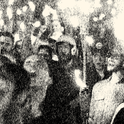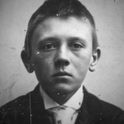Above: Mona, the eccentric vision of David Walsh
“Don’t let them call it ‘Australia’s Bilbao,’” pleads David Walsh, the man behind Mona, an extraordinary new art museum in Tasmania. “I hate that particular piece of architectural masturbation so much. Can’t I be Laputa or Shangri-La or Arcadia, or Disneyland? Anything other than Bilbao.”
“I know it’s a reference to the economic effect on an otherwise worthless backwater, but if Gehry met his brief in any way it must have been: ‘build something so over the top that it appeals to the lowest common denominator that divides all of us.’ Like a Rocky movie: escapism. But everyone likes Casablanca or Citizen Kane too—not because they dumb us down but because they lift us up.”
From its base in the conservative city of Hobart, a former penal colony, Mona—the Museum of Old and New Art—has started to pivot the eyes of the art world to the deep south, where winds come freshly whipped from Antarctica. Nothing on Australian soil has been as declarative, creatively, since the Sydney Opera House 40 years ago. It’s a game changer: soaringly beautiful, and touched with genius and boldness and wit.
After its official unveiling in January 2011, the world’s art mavens began to flock to it, along with the people of the island state. A regular Sunday scene is elderly couples dressed to the nines. “We love this place,” one blue-rinsed lady declares; “we come here all the time,” her partner in his careful cardigan adds. They step from the circular James Bond-like pod that’s plunged them deep into the cliff face and make their way past the beautiful ceramics hung like wonky plates in a long line on a wall. Hang on—on closer look the ceramics are plaster casts of vaginas, all different shapes and sizes. The couple heads towards an ethereal black Madonna floating in a sea of gold, resting on elephant dung and surrounded by butterflies that look like petals—but up close you can see they’re female bottoms. The couple take their time, then retire to a golden chair on a mountain lion rug facing the work, gazing at the perplexing vision.
From the water droplets spelling out the most popular words on Google News to the bathroom mirrors in which you can watch yourself going to the loo to the café’s blood-red macaroon on its black napkin and white plate, everything’s been meticulously thought out. It’s one man’s eccentric, controlling, breathtaking vision. Step forward David Walsh, Hobart born and bred. His middle-aged body is shown buck naked in the gallery catalogue. Walsh is a mathematical genius who made his money from gambling on sports; he could have bought 100 yachts and that would have been the boring end of him. Instead, he’s done this: one of the most exhilarating acts of public generosity Australia has ever seen. We don’t have a tradition of grand philanthropic gestures like the US but, by God, he’s showed up those who’ve made their gluttonous wealth from the mineral-rich land.
The visitors—many of them locals, for whom it is free—look as if they’ve had a shot of oxygen. It’s invigorating in the way of great art: bringing you closer to the wonder of what it is to be human in all its ugliness, but in all its ravishing beauty too. Damien Hirst, Gerhard Richter, Chris Ofili are here, alongside Sidney Nolan and exquisite ancient Egyptian jewellery. Mona is the antithesis of a museum of hushed tones and fusty cabinets; it welcomes wonder. It outrages, seduces, moves, repels but never dulls. There’s something so Australian about the vaulting audacity, springing from seemingly nowhere. Why shouldn’t I build the coolest modern art museum in the world? No one’s told me I can’t, so I will.
The building is carved deep into a sandstone cliff, its muscular walls exposed; they change, weep, blush with growth after strong rain. Walsh lives here: the glass floor of his apartment is the roof of a gallery corner. You may see him looking down at you roaming his wonderland; you may catch his cat called Christ padding about the exhibits. His sister designed the funky staff jackets and his father’s ashes are displayed in an urn; “Rosebud” touches of the personal that pulse through the place. Walsh is Australia’s enigmatic Citizen Kane, who has given his nation something as intriguing and enduring as John Soane’s Museum or the Frick—one man’s vision, built around the endearing domesticity of his own house in an Australian backwater. “Conservative places need to be shaken up occasionally,” he says. “Tasmania needs Mona like California needs the San Andreas.”
“Don’t let them call it ‘Australia’s Bilbao,’” pleads David Walsh, the man behind Mona, an extraordinary new art museum in Tasmania. “I hate that particular piece of architectural masturbation so much. Can’t I be Laputa or Shangri-La or Arcadia, or Disneyland? Anything other than Bilbao.”
“I know it’s a reference to the economic effect on an otherwise worthless backwater, but if Gehry met his brief in any way it must have been: ‘build something so over the top that it appeals to the lowest common denominator that divides all of us.’ Like a Rocky movie: escapism. But everyone likes Casablanca or Citizen Kane too—not because they dumb us down but because they lift us up.”
From its base in the conservative city of Hobart, a former penal colony, Mona—the Museum of Old and New Art—has started to pivot the eyes of the art world to the deep south, where winds come freshly whipped from Antarctica. Nothing on Australian soil has been as declarative, creatively, since the Sydney Opera House 40 years ago. It’s a game changer: soaringly beautiful, and touched with genius and boldness and wit.
After its official unveiling in January 2011, the world’s art mavens began to flock to it, along with the people of the island state. A regular Sunday scene is elderly couples dressed to the nines. “We love this place,” one blue-rinsed lady declares; “we come here all the time,” her partner in his careful cardigan adds. They step from the circular James Bond-like pod that’s plunged them deep into the cliff face and make their way past the beautiful ceramics hung like wonky plates in a long line on a wall. Hang on—on closer look the ceramics are plaster casts of vaginas, all different shapes and sizes. The couple heads towards an ethereal black Madonna floating in a sea of gold, resting on elephant dung and surrounded by butterflies that look like petals—but up close you can see they’re female bottoms. The couple take their time, then retire to a golden chair on a mountain lion rug facing the work, gazing at the perplexing vision.
From the water droplets spelling out the most popular words on Google News to the bathroom mirrors in which you can watch yourself going to the loo to the café’s blood-red macaroon on its black napkin and white plate, everything’s been meticulously thought out. It’s one man’s eccentric, controlling, breathtaking vision. Step forward David Walsh, Hobart born and bred. His middle-aged body is shown buck naked in the gallery catalogue. Walsh is a mathematical genius who made his money from gambling on sports; he could have bought 100 yachts and that would have been the boring end of him. Instead, he’s done this: one of the most exhilarating acts of public generosity Australia has ever seen. We don’t have a tradition of grand philanthropic gestures like the US but, by God, he’s showed up those who’ve made their gluttonous wealth from the mineral-rich land.
The visitors—many of them locals, for whom it is free—look as if they’ve had a shot of oxygen. It’s invigorating in the way of great art: bringing you closer to the wonder of what it is to be human in all its ugliness, but in all its ravishing beauty too. Damien Hirst, Gerhard Richter, Chris Ofili are here, alongside Sidney Nolan and exquisite ancient Egyptian jewellery. Mona is the antithesis of a museum of hushed tones and fusty cabinets; it welcomes wonder. It outrages, seduces, moves, repels but never dulls. There’s something so Australian about the vaulting audacity, springing from seemingly nowhere. Why shouldn’t I build the coolest modern art museum in the world? No one’s told me I can’t, so I will.
The building is carved deep into a sandstone cliff, its muscular walls exposed; they change, weep, blush with growth after strong rain. Walsh lives here: the glass floor of his apartment is the roof of a gallery corner. You may see him looking down at you roaming his wonderland; you may catch his cat called Christ padding about the exhibits. His sister designed the funky staff jackets and his father’s ashes are displayed in an urn; “Rosebud” touches of the personal that pulse through the place. Walsh is Australia’s enigmatic Citizen Kane, who has given his nation something as intriguing and enduring as John Soane’s Museum or the Frick—one man’s vision, built around the endearing domesticity of his own house in an Australian backwater. “Conservative places need to be shaken up occasionally,” he says. “Tasmania needs Mona like California needs the San Andreas.”












